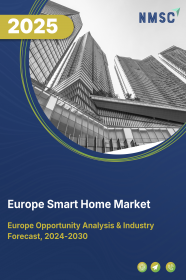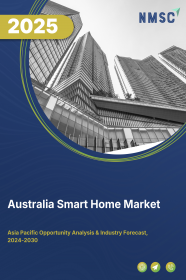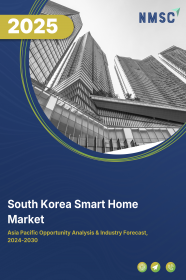
Europe Smart Home Market by Product Type (Smart Lighting, Smart Home Security & Surveillance, Smart Entertainment, and Smart Appliances), by Communication Protocol (Wi-Fi, Zigbee, Z-Wave, Bluetooth, and Thread), by Smart Home Hubs (Standalone Hubs and Built-in Hubs), by Voice Assistants Integration (Amazon Alexa, Google Assistant, Apple Siri, and Others) –Opportunity Analysis and Industry Forecast, 2024–2030
Industry: Retail and Consumer | Publish Date: 15-Feb-2025 | No of Pages: 282 | No. of Tables: 189 | No. of Figures: 154 | Format: PDF | Report Code : RC2276
US Tariff Impact on Europe Smart Home Market
Trump Tariffs Are Reshaping Global Business
Europe Smart Home Market Overview
The Europe Smart Home Market size was valued at USD 34.08 billion in 2023, and is predicted to reach USD 119.22 billion by 2030, at a CAGR of 19.6% from 2024 to 2030. A smart home, alternatively termed a connected home, denotes a dwelling furnished with cutting-edge technology and automation systems facilitating the centralized control and surveillance of diverse household devices, appliances, and security features via a unified network. These intelligent devices are remotely operable and frequently responsive to voice commands or predefined schedules, thereby augmenting convenience, energy efficiency, and security for homeowners. Common components of connected homes encompass smart thermostats, lighting systems, security cameras, voice assistants, and other interconnected devices aimed at enhancing the overall residential lifestyle.
Rising Awareness of Energy Efficiency and Sustainability Drives the Europe Smart Home Market Growth
In Europe, a significant growth driver for the smart home market is the increasing awareness of energy efficiency and sustainability among consumers. With a growing concern for environmental preservation and a desire to reduce energy consumption, European homeowners are turning to connected home solutions to monitor and manage their energy usage more effectively.
Technologies such as smart thermostats, energy-efficient lighting systems, and home automation allow users to optimize energy usage, thereby lowering utility bills and reducing their carbon footprint. The emphasis on sustainability aligns with European Union directives and national policies promoting energy conservation, further driving the adoption of connected home technologies across the continent.
Government Initiatives and Incentives is Boosting the Growth of the Market
The support from government initiatives and incentives further enhances the growth of the market. Various European countries offer subsidies, tax credits, and grants to encourage the adoption of connected home technologies. These incentives aim to stimulate market demand, promote innovation, and accelerate the transition towards more sustainable and connected homes.
Additionally, regulatory frameworks and building codes often incorporate requirements for energy-efficient and smart-enabled homes, further incentivizing consumers and builders to invest in connected home solutions. The combination of government support and regulatory mandates creates a favourable environment for the growth of the connected home market in Europe.
Concerns Regarding Security and Data Privacy Pose a Constraint on Market Expansion
The growth of the smart home market encounters a significant impediment due to apprehensions surrounding security issues associated with these interconnected systems. Smart devices such as thermostats, cameras, and door locks are vulnerable to hacking attempts, posing potential threats to the privacy and safety of residents.
This vulnerability often originates from weak or easily penetrable passwords and insufficient security measures within Wi-Fi networks. Malicious actors exploit these vulnerabilities to gain unauthorized access, potentially manipulating devices or accessing sensitive data.
To address these risks, prudent homeowners must prioritize robust password management practices, consistently update device firmware, and fortify their home networks to diminish the likelihood of cyber-attacks and safeguard their connected homes against potential breaches.
Integration of Blockchain Technology into Smart Home Devices Presents Lucrative Opportunity for Market Expansion
The introduction of blockchain technology into smart home devices holds considerable promise in elevating the security and privacy standards of connected home systems. Renowned for its robust security and transparency features, blockchain encrypts and securely stores sensitive connected home data, empowering users to regulate access permissions and mitigate the risk of unauthorized breaches.
By verifying device identities, blockchain ensures that only trusted devices interact within the connected home network, while also automating tasks through tamper-proof smart contracts. Furthermore, blockchain technology decentralizes device control, minimizes vulnerabilities, and facilitates transparent access control and permissions management. The integration of blockchain into connected homes not only enhances security and privacy but also fosters a safer and more confidential connected home environment, thus paving the way for significant growth opportunities within the market.
The UK Dominates the Europe Smart home Market Share
The rising prevalence of connected homes and interconnected devices propels the expansion of the smart home market in the UK. Smart technology adoption within households surged significantly, jumping from 14.9% in 2021 to 39.0% by 2022. Among the most coveted connected home features are lighting, heating, and security systems, with smart plugs gaining traction due to their remote power control capabilities.
Additionally, the presence of key players in the UK market serves as a driving force behind the growth of the smart home industry. Established and reputable companies maintain a robust presence, offering consumers a plethora of options and advanced robotic cleaning solutions.
For example, Centrica's Hive, a prominent player in the connected home sector, introduced an innovative connected home monitoring service. This service empowers homeowners to conveniently safeguard their residences using their smartphones. By providing accessible and intuitive ways to protect homes and loved ones, such offerings likely contribute to the enhancement of the connected home market.
Finland to Witness Substantial Growth in the Europe Smart home Market Trends
The increasing urbanization in Finland is fuelling the expansion of the smart home market in the country. With a growing proportion of the Finnish population migrating to urban centers, there is a noticeable upsurge in the demand for connected home automation. The appeal of urban living, characterized by its fast-paced lifestyle and modern conveniences, spurs the need for innovative solutions that simplify daily tasks.
This trend seamlessly aligns with the adoption of connected homes, which offer an efficient and time-saving approach to maintaining tidy living spaces. With approximately 85.8% of Finland's population residing in urban areas as of 2023, the market for autonomous cleaning devices is primed for significant growth, reflecting the broader global trend toward connected living and intelligent home solutions.
Furthermore, the rising disposable income in Finland paved the way for increased adoption of smart home appliances and cutting-edge technologies across the country. With an average household net-adjusted disposable income per capita of USD 33,471 annually, Finland surpasses the OECD average of USD 30,490 annually.
This higher income level enables Finnish households with the financial means to invest in advanced home automation solutions that enhance convenience and streamline daily routines. Among these solutions, connected homes emerged as a popular choice, allowing homeowners to enjoy cleaner living spaces with minimal effort. The robust economic landscape in Finland, characterized by the elevated disposable income of its residents, serves as a crucial driver in the growth of the connected home market within the nation.
Competitive Landscape
Several key players operating in the Europe smart home industry include LG Electronics, ASSA ABLOY, Amazon Inc., Samsung Electronics, Sony, Emerson Electronic Co., Johnson Controls International PLC, Centrica Connected Home Limited, Resideo Technologies Inc., Apple Inc. and others.
Europe Smart Home Market Key Segments
By Product Type
-
Smart Lighting
-
Smart Bulbs
-
Smart Light Strips
-
Smart Switches
-
-
Smart Home Security and Surveillance
-
Smart Cameras
-
Video Doorbells
-
Smart Locks
-
Security System
-
-
Smart Entertainment
-
Smart TVs
-
Smart Speakers
-
Streaming Devices
-
-
Smart Appliances
-
Smart Refrigerators
-
Smart Ovens
-
Smart Washing Machines
-
Smart Dishwashers
-
Smart Home HVAC Management
-
Other Smart Appliances
-
By Communication Protocol
-
Wi-Fi
-
Zigbee
-
Z-wave
-
Bluetooth
-
Thread
By Smart Home Hubs
-
Standalone Hubs
-
Built-in Hubs
By Voice Assistants Integration
-
Amazon Alexa
-
Google Assistant
-
Apple Siri
-
Others
By Smart Home Compatibility with Smartphones
-
iOS
-
Android
By Installation
-
DIY Installation
-
Professional Installation
By Sales Channel
-
Online Retailers
-
Retailers
By Country
-
The U.K.
-
Germany
-
France
-
Italy
-
Spain
-
Denmark
-
Netherlands
-
Finland
-
Sweden
-
Norway
-
Russia
-
Rest of Europe
REPORT SCOPE AND SEGMENTATION:
|
Parameters |
Details |
|
Market Size in 2023 |
USD 34.08 Billion |
|
Revenue Forecast in 2030 |
USD 119.22 Billion |
|
Growth Rate |
CAGR of 19.6% from 2024 to 2030 |
|
Analysis Period |
2023–2030 |
|
Base Year Considered |
2023 |
|
Forecast Period |
2024–2030 |
|
Market Size Estimation |
Billion (USD) |
|
Growth Factors |
|
|
Countries Covered |
12 |
|
Companies Profiled |
10 |
|
Market Share |
Available for 10 companies |
|
Customization Scope |
Free customization (equivalent up to 80 working hours of analysts) after purchase. Addition or alteration to country, regional, and segment scope. |
|
Pricing and Purchase Options |
Avail customized purchase options to meet your exact research needs. |
KEY PLAYERS
-
LG Electronics
-
ASSA ABLOY
-
Amazon Inc.
-
Samsung Electronics
-
Sony
-
Emerson Electronic Co.
-
Johnson Controls International PLC
-
Centrica Connected Home Limited
-
Resideo Technologies Inc.
-
Apple Inc.

















 Speak to Our Analyst
Speak to Our Analyst




















